Comprehensive Finance Case Study: Agency Costs and Investments
VerifiedAdded on 2023/06/12
|10
|1442
|229
Case Study
AI Summary
This assignment presents a comprehensive finance case study covering various aspects of financial management. It begins with a discussion of agency costs, defining them and illustrating their relevance to different business structures like sole proprietorships, partnerships, and corporations. The case study further explores agency costs related to financial manager roles, including capital budgeting, financing decisions, and working capital management, suggesting methods to mitigate these costs. It includes quantitative analysis involving loan amortization schedules, calculation of holding period returns for stocks (BHP, WBC, AGL), portfolio expected returns, portfolio beta, and application of the CAPM model to determine market risk premium. Finally, it provides solutions to short math questions related to present and future value calculations, bond valuation, and dividend growth models, offering a holistic view of financial concepts. Desklib provides access to similar solved assignments and past papers for students.
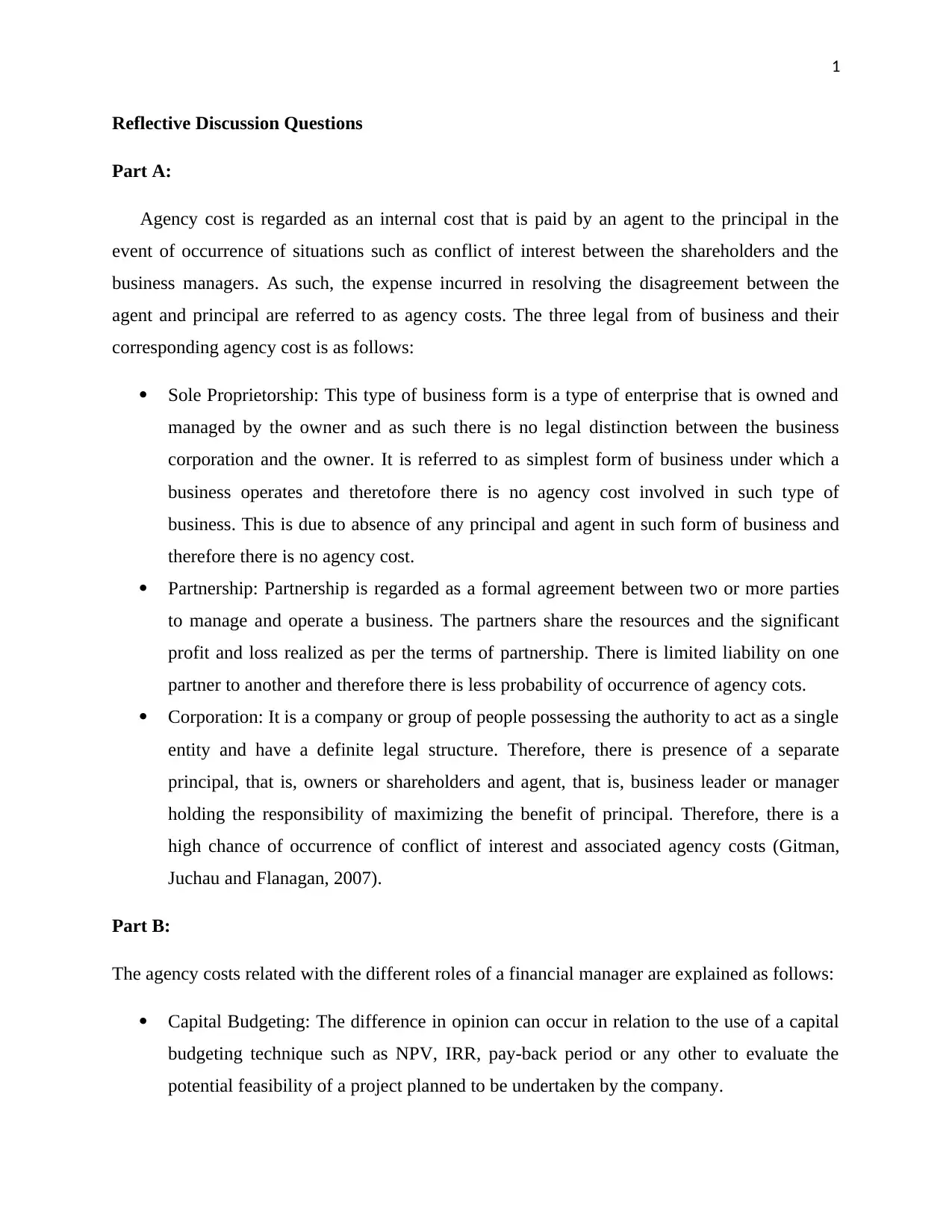
1
Reflective Discussion Questions
Part A:
Agency cost is regarded as an internal cost that is paid by an agent to the principal in the
event of occurrence of situations such as conflict of interest between the shareholders and the
business managers. As such, the expense incurred in resolving the disagreement between the
agent and principal are referred to as agency costs. The three legal from of business and their
corresponding agency cost is as follows:
Sole Proprietorship: This type of business form is a type of enterprise that is owned and
managed by the owner and as such there is no legal distinction between the business
corporation and the owner. It is referred to as simplest form of business under which a
business operates and theretofore there is no agency cost involved in such type of
business. This is due to absence of any principal and agent in such form of business and
therefore there is no agency cost.
Partnership: Partnership is regarded as a formal agreement between two or more parties
to manage and operate a business. The partners share the resources and the significant
profit and loss realized as per the terms of partnership. There is limited liability on one
partner to another and therefore there is less probability of occurrence of agency cots.
Corporation: It is a company or group of people possessing the authority to act as a single
entity and have a definite legal structure. Therefore, there is presence of a separate
principal, that is, owners or shareholders and agent, that is, business leader or manager
holding the responsibility of maximizing the benefit of principal. Therefore, there is a
high chance of occurrence of conflict of interest and associated agency costs (Gitman,
Juchau and Flanagan, 2007).
Part B:
The agency costs related with the different roles of a financial manager are explained as follows:
Capital Budgeting: The difference in opinion can occur in relation to the use of a capital
budgeting technique such as NPV, IRR, pay-back period or any other to evaluate the
potential feasibility of a project planned to be undertaken by the company.
Reflective Discussion Questions
Part A:
Agency cost is regarded as an internal cost that is paid by an agent to the principal in the
event of occurrence of situations such as conflict of interest between the shareholders and the
business managers. As such, the expense incurred in resolving the disagreement between the
agent and principal are referred to as agency costs. The three legal from of business and their
corresponding agency cost is as follows:
Sole Proprietorship: This type of business form is a type of enterprise that is owned and
managed by the owner and as such there is no legal distinction between the business
corporation and the owner. It is referred to as simplest form of business under which a
business operates and theretofore there is no agency cost involved in such type of
business. This is due to absence of any principal and agent in such form of business and
therefore there is no agency cost.
Partnership: Partnership is regarded as a formal agreement between two or more parties
to manage and operate a business. The partners share the resources and the significant
profit and loss realized as per the terms of partnership. There is limited liability on one
partner to another and therefore there is less probability of occurrence of agency cots.
Corporation: It is a company or group of people possessing the authority to act as a single
entity and have a definite legal structure. Therefore, there is presence of a separate
principal, that is, owners or shareholders and agent, that is, business leader or manager
holding the responsibility of maximizing the benefit of principal. Therefore, there is a
high chance of occurrence of conflict of interest and associated agency costs (Gitman,
Juchau and Flanagan, 2007).
Part B:
The agency costs related with the different roles of a financial manager are explained as follows:
Capital Budgeting: The difference in opinion can occur in relation to the use of a capital
budgeting technique such as NPV, IRR, pay-back period or any other to evaluate the
potential feasibility of a project planned to be undertaken by the company.
Paraphrase This Document
Need a fresh take? Get an instant paraphrase of this document with our AI Paraphraser
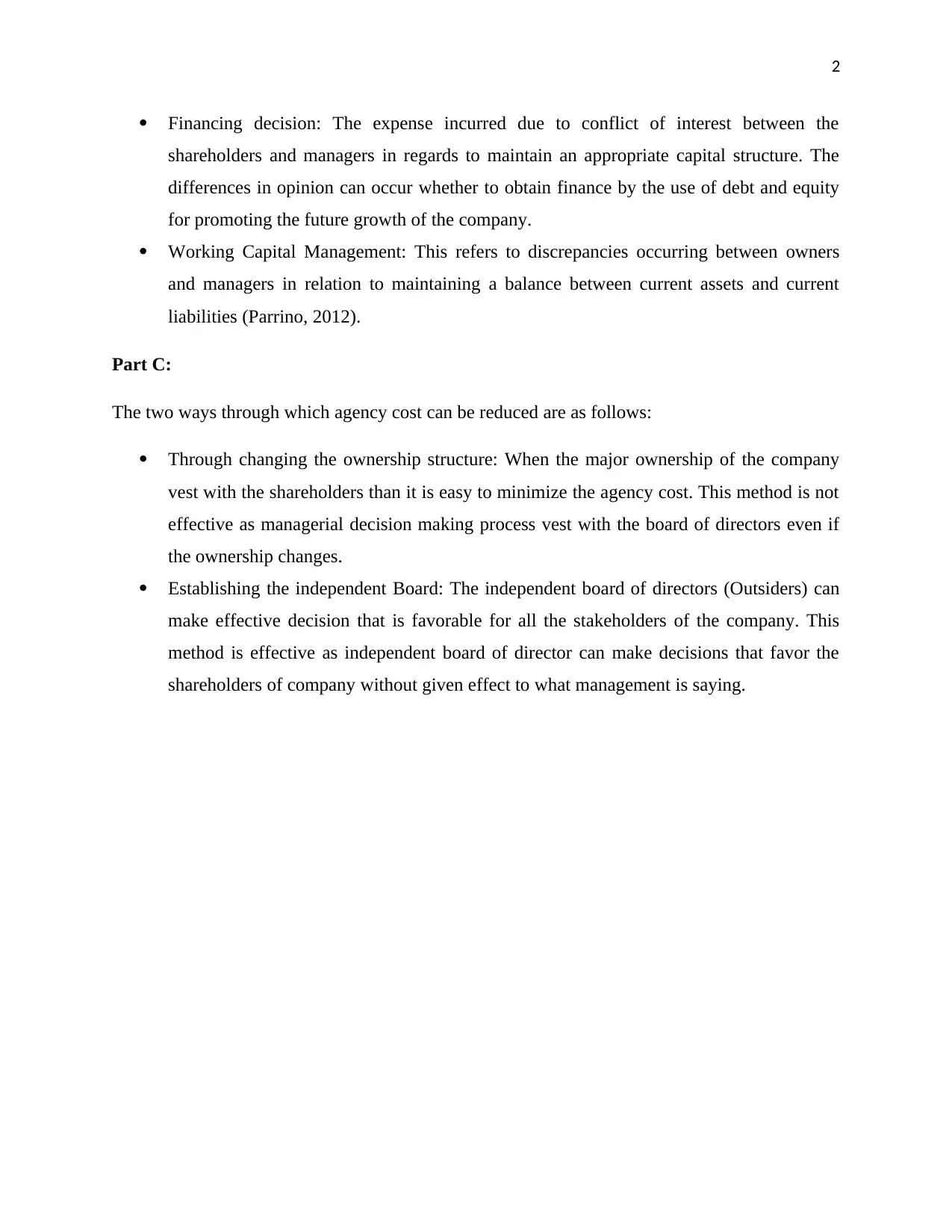
2
Financing decision: The expense incurred due to conflict of interest between the
shareholders and managers in regards to maintain an appropriate capital structure. The
differences in opinion can occur whether to obtain finance by the use of debt and equity
for promoting the future growth of the company.
Working Capital Management: This refers to discrepancies occurring between owners
and managers in relation to maintaining a balance between current assets and current
liabilities (Parrino, 2012).
Part C:
The two ways through which agency cost can be reduced are as follows:
Through changing the ownership structure: When the major ownership of the company
vest with the shareholders than it is easy to minimize the agency cost. This method is not
effective as managerial decision making process vest with the board of directors even if
the ownership changes.
Establishing the independent Board: The independent board of directors (Outsiders) can
make effective decision that is favorable for all the stakeholders of the company. This
method is effective as independent board of director can make decisions that favor the
shareholders of company without given effect to what management is saying.
Financing decision: The expense incurred due to conflict of interest between the
shareholders and managers in regards to maintain an appropriate capital structure. The
differences in opinion can occur whether to obtain finance by the use of debt and equity
for promoting the future growth of the company.
Working Capital Management: This refers to discrepancies occurring between owners
and managers in relation to maintaining a balance between current assets and current
liabilities (Parrino, 2012).
Part C:
The two ways through which agency cost can be reduced are as follows:
Through changing the ownership structure: When the major ownership of the company
vest with the shareholders than it is easy to minimize the agency cost. This method is not
effective as managerial decision making process vest with the board of directors even if
the ownership changes.
Establishing the independent Board: The independent board of directors (Outsiders) can
make effective decision that is favorable for all the stakeholders of the company. This
method is effective as independent board of director can make decisions that favor the
shareholders of company without given effect to what management is saying.
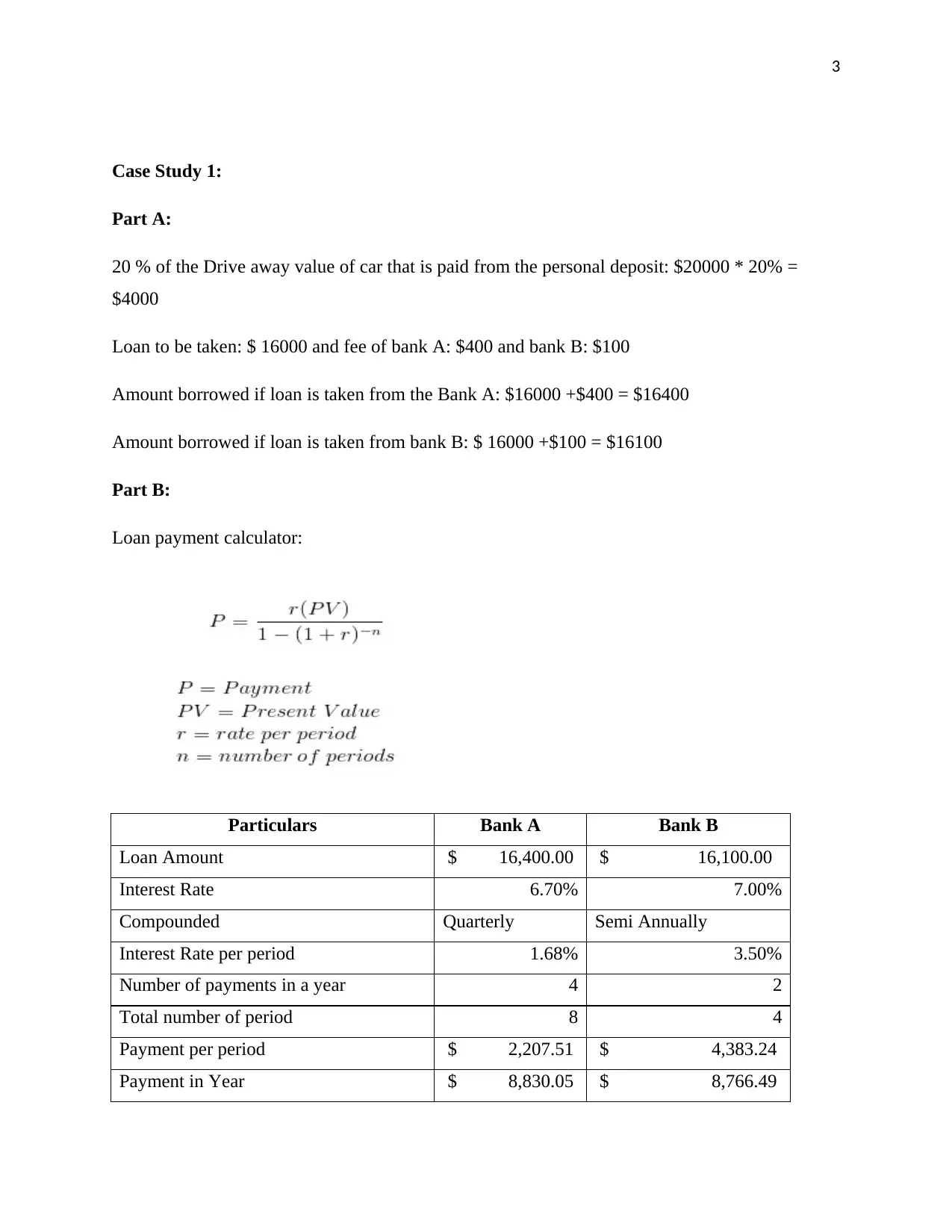
3
Case Study 1:
Part A:
20 % of the Drive away value of car that is paid from the personal deposit: $20000 * 20% =
$4000
Loan to be taken: $ 16000 and fee of bank A: $400 and bank B: $100
Amount borrowed if loan is taken from the Bank A: $16000 +$400 = $16400
Amount borrowed if loan is taken from bank B: $ 16000 +$100 = $16100
Part B:
Loan payment calculator:
Particulars Bank A Bank B
Loan Amount $ 16,400.00 $ 16,100.00
Interest Rate 6.70% 7.00%
Compounded Quarterly Semi Annually
Interest Rate per period 1.68% 3.50%
Number of payments in a year 4 2
Total number of period 8 4
Payment per period $ 2,207.51 $ 4,383.24
Payment in Year $ 8,830.05 $ 8,766.49
Case Study 1:
Part A:
20 % of the Drive away value of car that is paid from the personal deposit: $20000 * 20% =
$4000
Loan to be taken: $ 16000 and fee of bank A: $400 and bank B: $100
Amount borrowed if loan is taken from the Bank A: $16000 +$400 = $16400
Amount borrowed if loan is taken from bank B: $ 16000 +$100 = $16100
Part B:
Loan payment calculator:
Particulars Bank A Bank B
Loan Amount $ 16,400.00 $ 16,100.00
Interest Rate 6.70% 7.00%
Compounded Quarterly Semi Annually
Interest Rate per period 1.68% 3.50%
Number of payments in a year 4 2
Total number of period 8 4
Payment per period $ 2,207.51 $ 4,383.24
Payment in Year $ 8,830.05 $ 8,766.49
⊘ This is a preview!⊘
Do you want full access?
Subscribe today to unlock all pages.

Trusted by 1+ million students worldwide
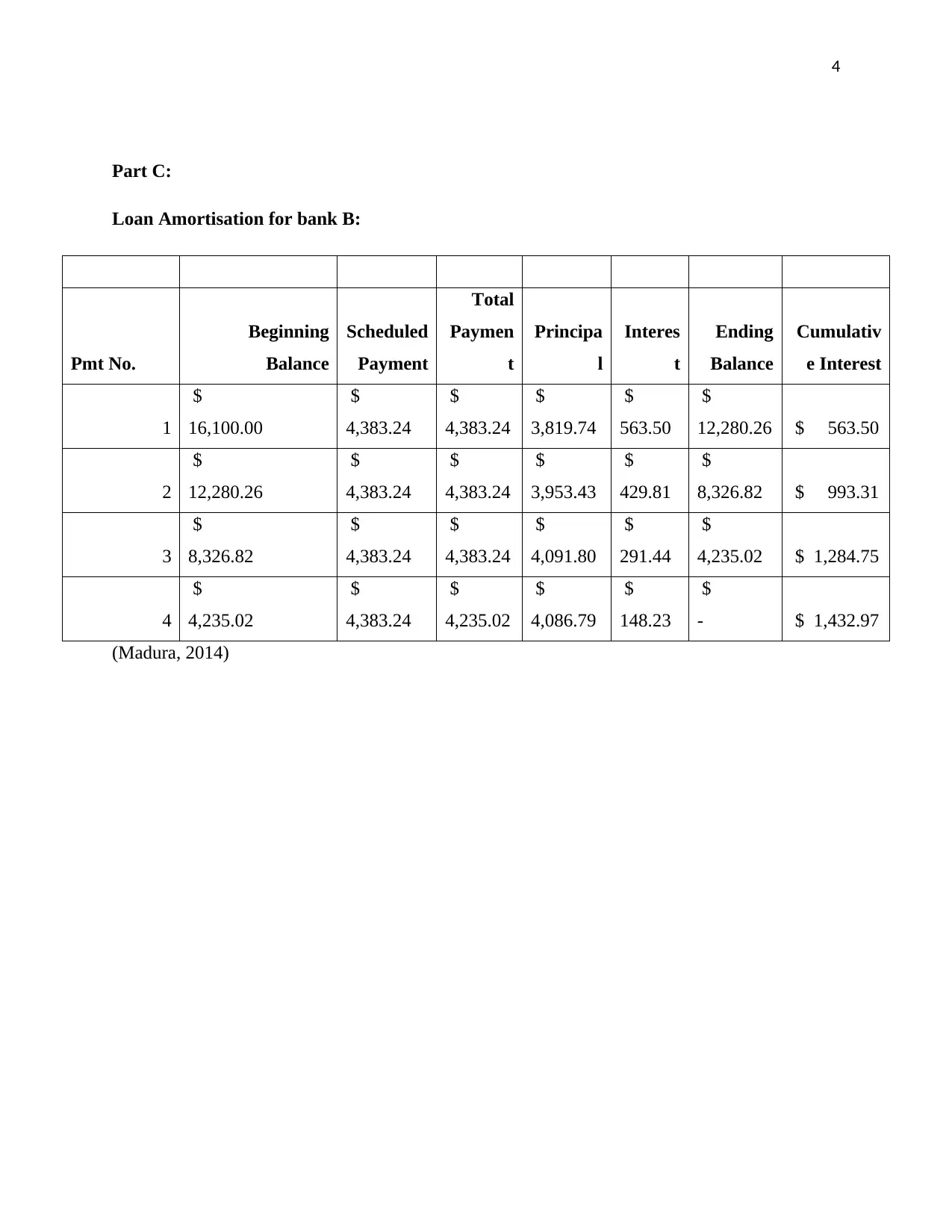
4
Part C:
Loan Amortisation for bank B:
Pmt No.
Beginning
Balance
Scheduled
Payment
Total
Paymen
t
Principa
l
Interes
t
Ending
Balance
Cumulativ
e Interest
1
$
16,100.00
$
4,383.24
$
4,383.24
$
3,819.74
$
563.50
$
12,280.26 $ 563.50
2
$
12,280.26
$
4,383.24
$
4,383.24
$
3,953.43
$
429.81
$
8,326.82 $ 993.31
3
$
8,326.82
$
4,383.24
$
4,383.24
$
4,091.80
$
291.44
$
4,235.02 $ 1,284.75
4
$
4,235.02
$
4,383.24
$
4,235.02
$
4,086.79
$
148.23
$
- $ 1,432.97
(Madura, 2014)
Part C:
Loan Amortisation for bank B:
Pmt No.
Beginning
Balance
Scheduled
Payment
Total
Paymen
t
Principa
l
Interes
t
Ending
Balance
Cumulativ
e Interest
1
$
16,100.00
$
4,383.24
$
4,383.24
$
3,819.74
$
563.50
$
12,280.26 $ 563.50
2
$
12,280.26
$
4,383.24
$
4,383.24
$
3,953.43
$
429.81
$
8,326.82 $ 993.31
3
$
8,326.82
$
4,383.24
$
4,383.24
$
4,091.80
$
291.44
$
4,235.02 $ 1,284.75
4
$
4,235.02
$
4,383.24
$
4,235.02
$
4,086.79
$
148.23
$
- $ 1,432.97
(Madura, 2014)
Paraphrase This Document
Need a fresh take? Get an instant paraphrase of this document with our AI Paraphraser
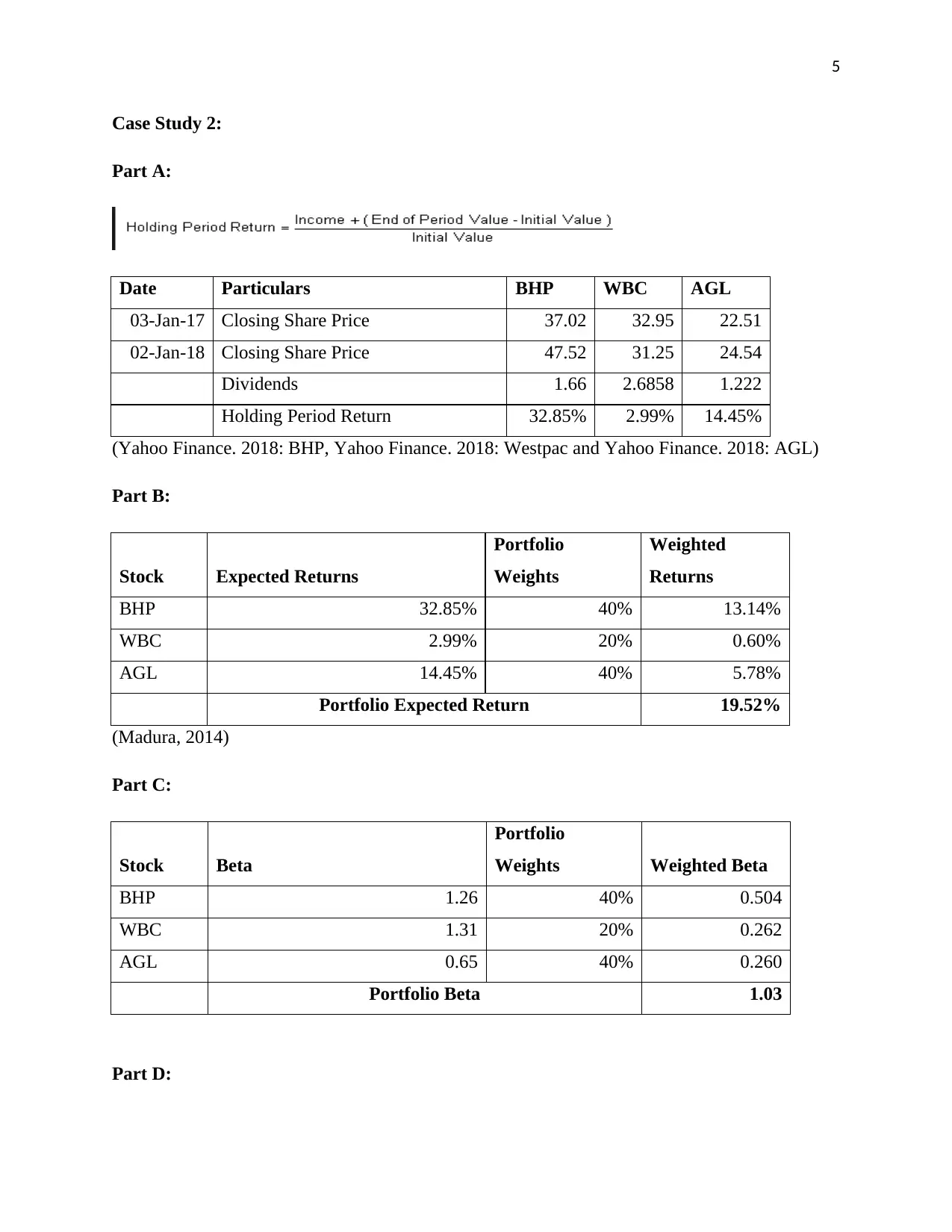
5
Case Study 2:
Part A:
Date Particulars BHP WBC AGL
03-Jan-17 Closing Share Price 37.02 32.95 22.51
02-Jan-18 Closing Share Price 47.52 31.25 24.54
Dividends 1.66 2.6858 1.222
Holding Period Return 32.85% 2.99% 14.45%
(Yahoo Finance. 2018: BHP, Yahoo Finance. 2018: Westpac and Yahoo Finance. 2018: AGL)
Part B:
Stock Expected Returns
Portfolio
Weights
Weighted
Returns
BHP 32.85% 40% 13.14%
WBC 2.99% 20% 0.60%
AGL 14.45% 40% 5.78%
Portfolio Expected Return 19.52%
(Madura, 2014)
Part C:
Stock Beta
Portfolio
Weights Weighted Beta
BHP 1.26 40% 0.504
WBC 1.31 20% 0.262
AGL 0.65 40% 0.260
Portfolio Beta 1.03
Part D:
Case Study 2:
Part A:
Date Particulars BHP WBC AGL
03-Jan-17 Closing Share Price 37.02 32.95 22.51
02-Jan-18 Closing Share Price 47.52 31.25 24.54
Dividends 1.66 2.6858 1.222
Holding Period Return 32.85% 2.99% 14.45%
(Yahoo Finance. 2018: BHP, Yahoo Finance. 2018: Westpac and Yahoo Finance. 2018: AGL)
Part B:
Stock Expected Returns
Portfolio
Weights
Weighted
Returns
BHP 32.85% 40% 13.14%
WBC 2.99% 20% 0.60%
AGL 14.45% 40% 5.78%
Portfolio Expected Return 19.52%
(Madura, 2014)
Part C:
Stock Beta
Portfolio
Weights Weighted Beta
BHP 1.26 40% 0.504
WBC 1.31 20% 0.262
AGL 0.65 40% 0.260
Portfolio Beta 1.03
Part D:
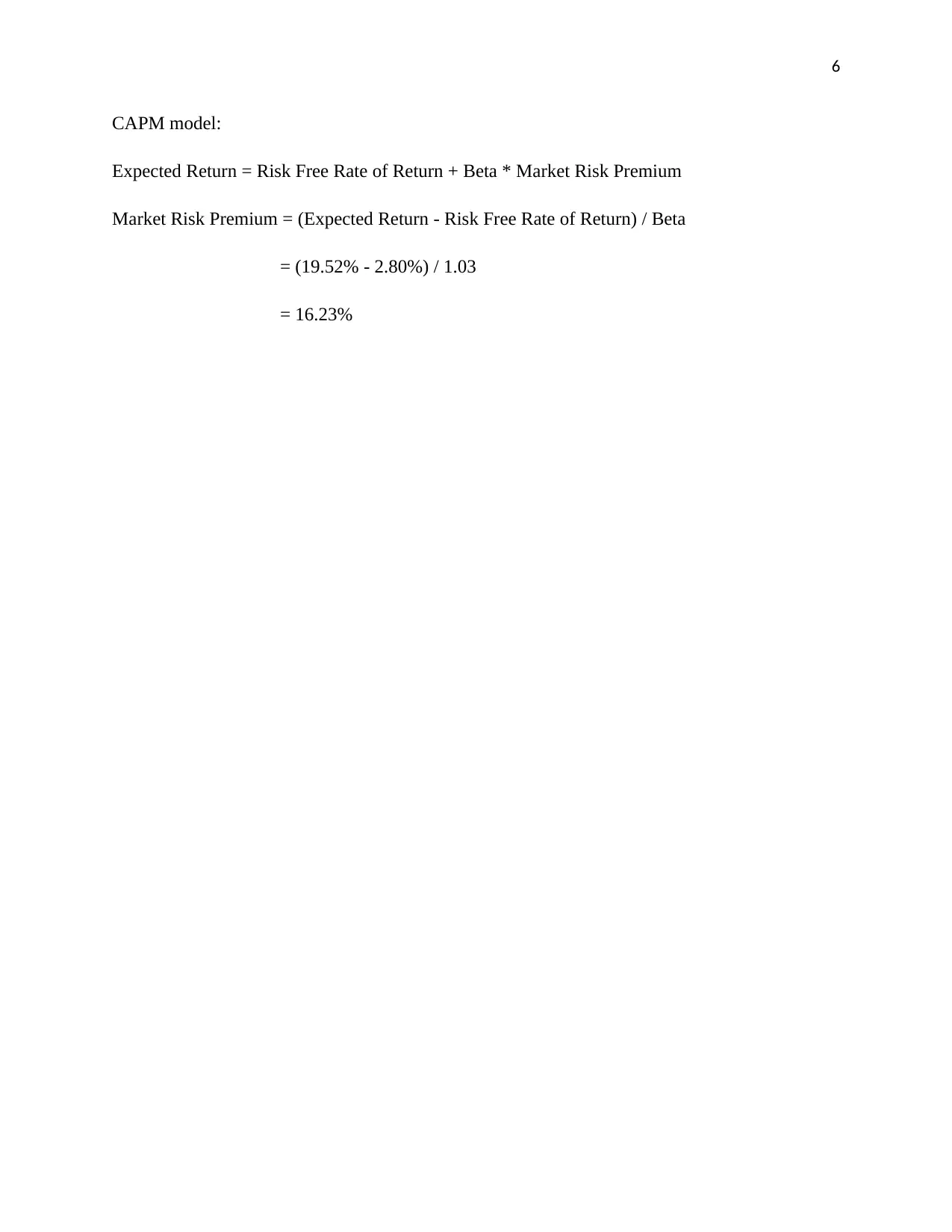
6
CAPM model:
Expected Return = Risk Free Rate of Return + Beta * Market Risk Premium
Market Risk Premium = (Expected Return - Risk Free Rate of Return) / Beta
= (19.52% - 2.80%) / 1.03
= 16.23%
CAPM model:
Expected Return = Risk Free Rate of Return + Beta * Market Risk Premium
Market Risk Premium = (Expected Return - Risk Free Rate of Return) / Beta
= (19.52% - 2.80%) / 1.03
= 16.23%
⊘ This is a preview!⊘
Do you want full access?
Subscribe today to unlock all pages.

Trusted by 1+ million students worldwide
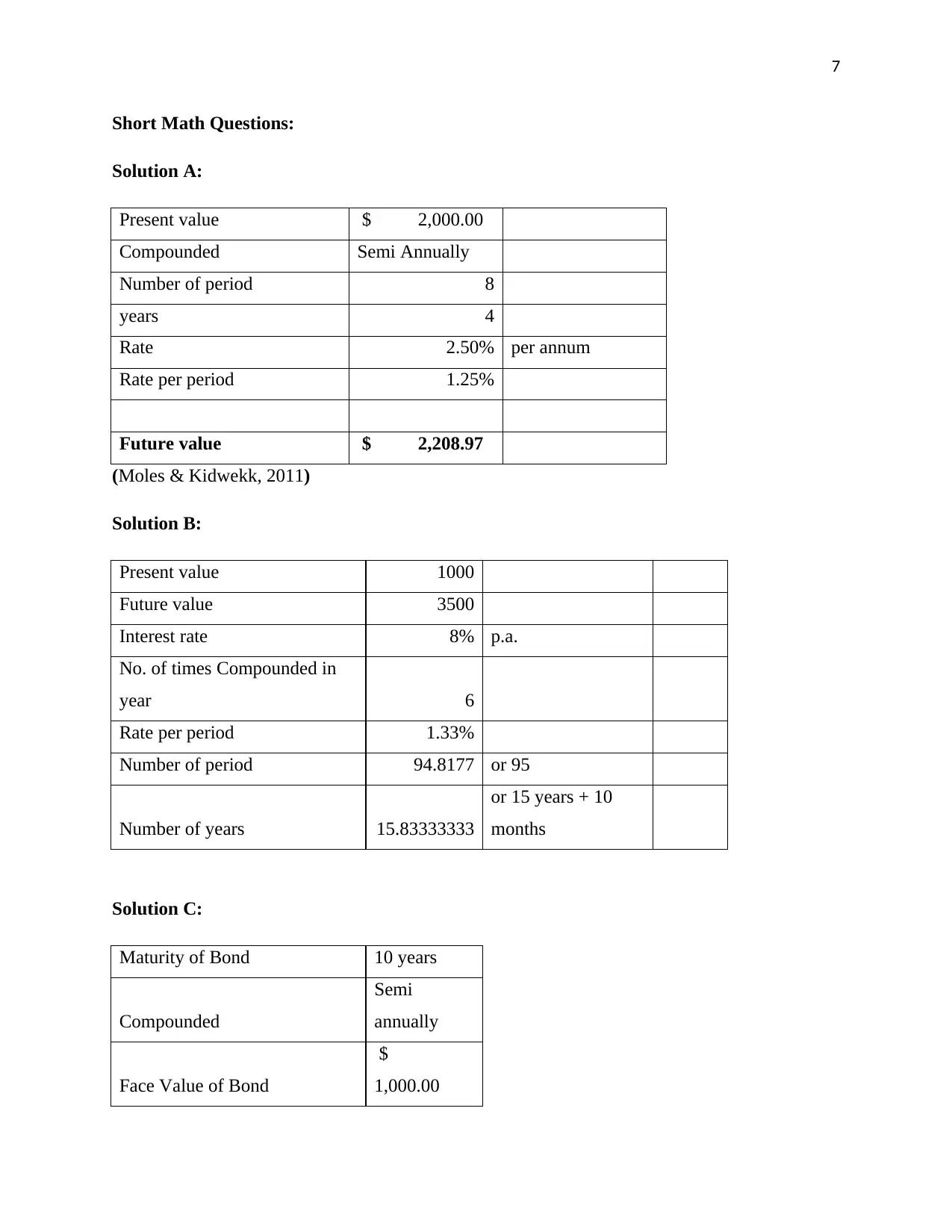
7
Short Math Questions:
Solution A:
Present value $ 2,000.00
Compounded Semi Annually
Number of period 8
years 4
Rate 2.50% per annum
Rate per period 1.25%
Future value $ 2,208.97
(Moles & Kidwekk, 2011)
Solution B:
Present value 1000
Future value 3500
Interest rate 8% p.a.
No. of times Compounded in
year 6
Rate per period 1.33%
Number of period 94.8177 or 95
Number of years 15.83333333
or 15 years + 10
months
Solution C:
Maturity of Bond 10 years
Compounded
Semi
annually
Face Value of Bond
$
1,000.00
Short Math Questions:
Solution A:
Present value $ 2,000.00
Compounded Semi Annually
Number of period 8
years 4
Rate 2.50% per annum
Rate per period 1.25%
Future value $ 2,208.97
(Moles & Kidwekk, 2011)
Solution B:
Present value 1000
Future value 3500
Interest rate 8% p.a.
No. of times Compounded in
year 6
Rate per period 1.33%
Number of period 94.8177 or 95
Number of years 15.83333333
or 15 years + 10
months
Solution C:
Maturity of Bond 10 years
Compounded
Semi
annually
Face Value of Bond
$
1,000.00
Paraphrase This Document
Need a fresh take? Get an instant paraphrase of this document with our AI Paraphraser
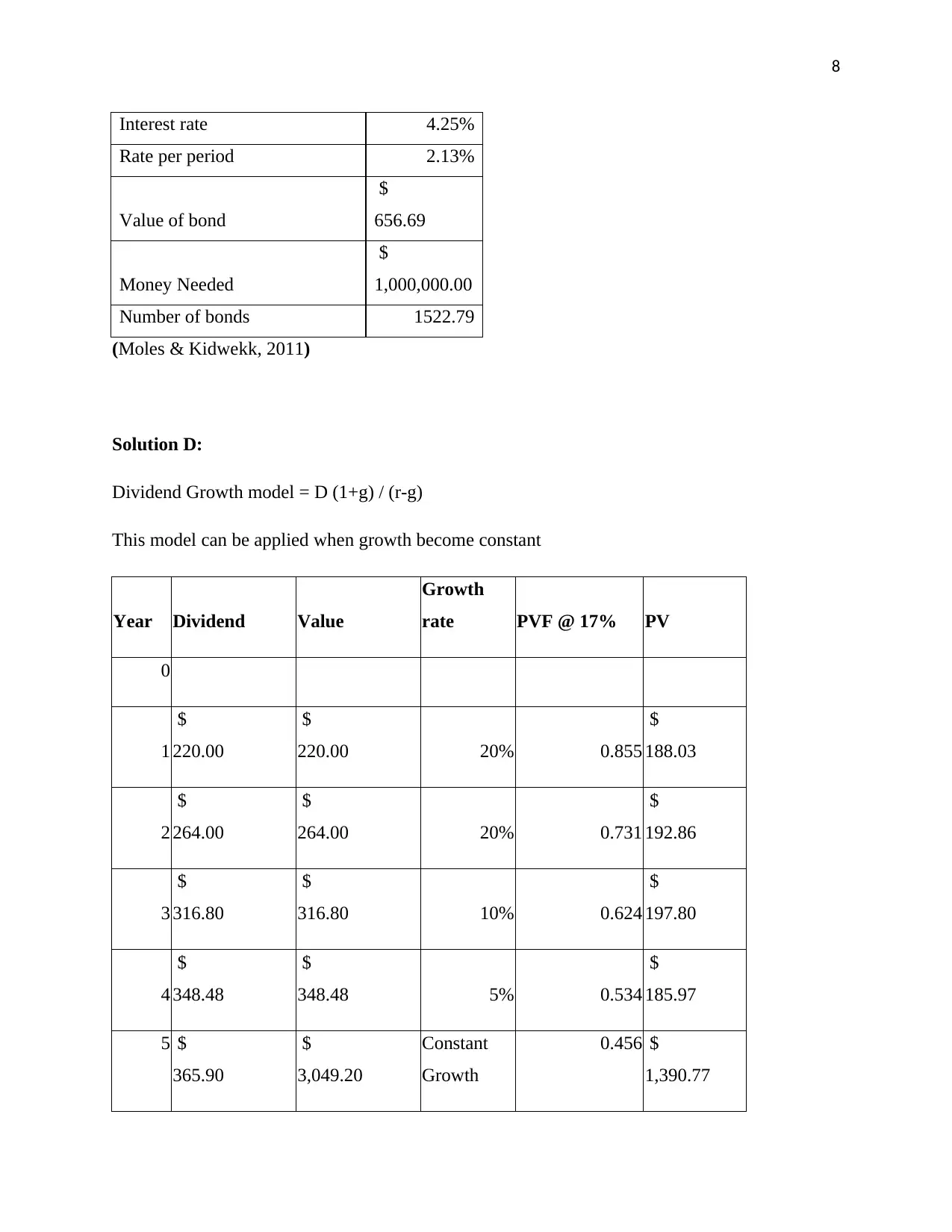
8
Interest rate 4.25%
Rate per period 2.13%
Value of bond
$
656.69
Money Needed
$
1,000,000.00
Number of bonds 1522.79
(Moles & Kidwekk, 2011)
Solution D:
Dividend Growth model = D (1+g) / (r-g)
This model can be applied when growth become constant
Year Dividend Value
Growth
rate PVF @ 17% PV
0
1
$
220.00
$
220.00 20% 0.855
$
188.03
2
$
264.00
$
264.00 20% 0.731
$
192.86
3
$
316.80
$
316.80 10% 0.624
$
197.80
4
$
348.48
$
348.48 5% 0.534
$
185.97
5 $
365.90
$
3,049.20
Constant
Growth
0.456 $
1,390.77
Interest rate 4.25%
Rate per period 2.13%
Value of bond
$
656.69
Money Needed
$
1,000,000.00
Number of bonds 1522.79
(Moles & Kidwekk, 2011)
Solution D:
Dividend Growth model = D (1+g) / (r-g)
This model can be applied when growth become constant
Year Dividend Value
Growth
rate PVF @ 17% PV
0
1
$
220.00
$
220.00 20% 0.855
$
188.03
2
$
264.00
$
264.00 20% 0.731
$
192.86
3
$
316.80
$
316.80 10% 0.624
$
197.80
4
$
348.48
$
348.48 5% 0.534
$
185.97
5 $
365.90
$
3,049.20
Constant
Growth
0.456 $
1,390.77
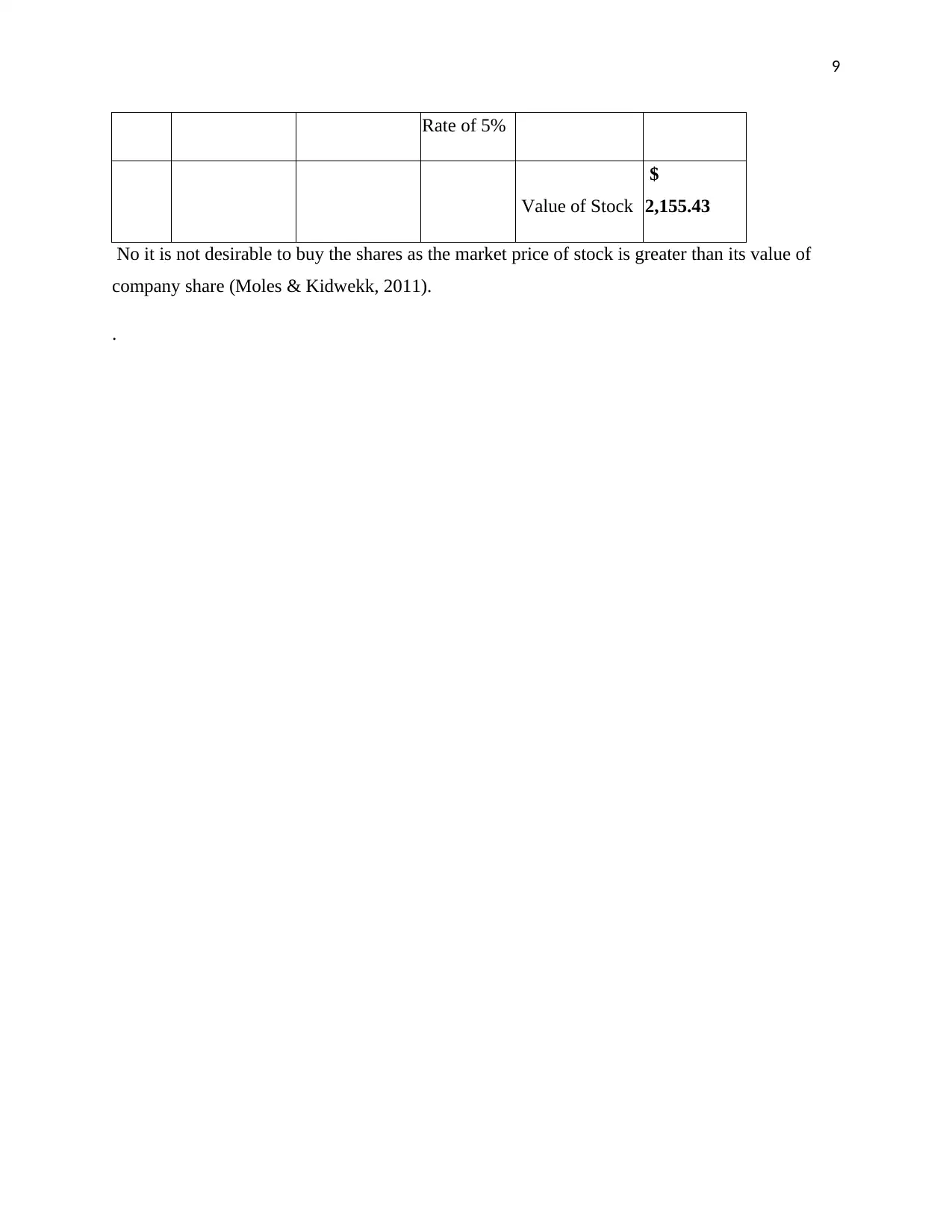
9
Rate of 5%
Value of Stock
$
2,155.43
No it is not desirable to buy the shares as the market price of stock is greater than its value of
company share (Moles & Kidwekk, 2011).
.
Rate of 5%
Value of Stock
$
2,155.43
No it is not desirable to buy the shares as the market price of stock is greater than its value of
company share (Moles & Kidwekk, 2011).
.
⊘ This is a preview!⊘
Do you want full access?
Subscribe today to unlock all pages.

Trusted by 1+ million students worldwide
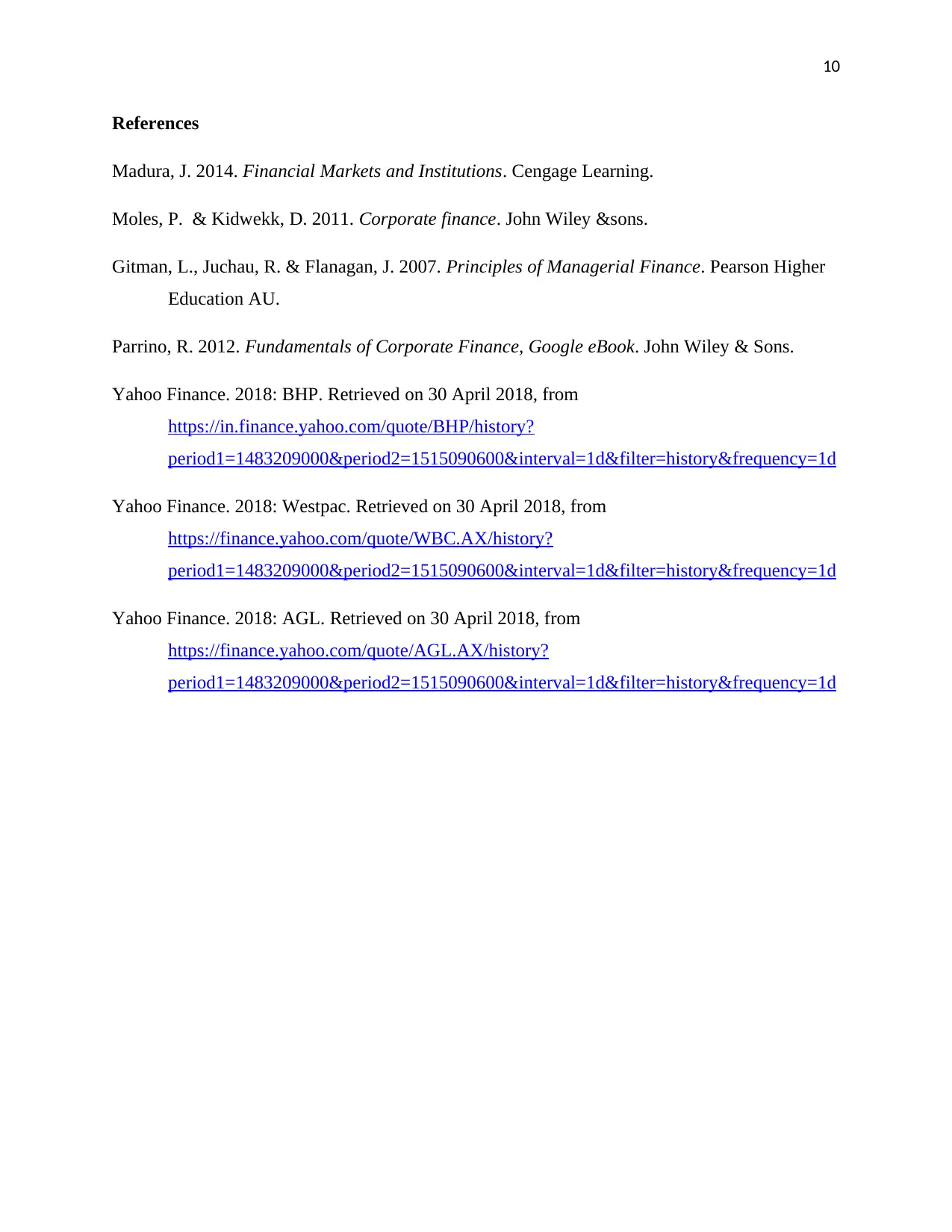
10
References
Madura, J. 2014. Financial Markets and Institutions. Cengage Learning.
Moles, P. & Kidwekk, D. 2011. Corporate finance. John Wiley &sons.
Gitman, L., Juchau, R. & Flanagan, J. 2007. Principles of Managerial Finance. Pearson Higher
Education AU.
Parrino, R. 2012. Fundamentals of Corporate Finance, Google eBook. John Wiley & Sons.
Yahoo Finance. 2018: BHP. Retrieved on 30 April 2018, from
https://in.finance.yahoo.com/quote/BHP/history?
period1=1483209000&period2=1515090600&interval=1d&filter=history&frequency=1d
Yahoo Finance. 2018: Westpac. Retrieved on 30 April 2018, from
https://finance.yahoo.com/quote/WBC.AX/history?
period1=1483209000&period2=1515090600&interval=1d&filter=history&frequency=1d
Yahoo Finance. 2018: AGL. Retrieved on 30 April 2018, from
https://finance.yahoo.com/quote/AGL.AX/history?
period1=1483209000&period2=1515090600&interval=1d&filter=history&frequency=1d
References
Madura, J. 2014. Financial Markets and Institutions. Cengage Learning.
Moles, P. & Kidwekk, D. 2011. Corporate finance. John Wiley &sons.
Gitman, L., Juchau, R. & Flanagan, J. 2007. Principles of Managerial Finance. Pearson Higher
Education AU.
Parrino, R. 2012. Fundamentals of Corporate Finance, Google eBook. John Wiley & Sons.
Yahoo Finance. 2018: BHP. Retrieved on 30 April 2018, from
https://in.finance.yahoo.com/quote/BHP/history?
period1=1483209000&period2=1515090600&interval=1d&filter=history&frequency=1d
Yahoo Finance. 2018: Westpac. Retrieved on 30 April 2018, from
https://finance.yahoo.com/quote/WBC.AX/history?
period1=1483209000&period2=1515090600&interval=1d&filter=history&frequency=1d
Yahoo Finance. 2018: AGL. Retrieved on 30 April 2018, from
https://finance.yahoo.com/quote/AGL.AX/history?
period1=1483209000&period2=1515090600&interval=1d&filter=history&frequency=1d
1 out of 10
Related Documents
Your All-in-One AI-Powered Toolkit for Academic Success.
+13062052269
info@desklib.com
Available 24*7 on WhatsApp / Email
![[object Object]](/_next/static/media/star-bottom.7253800d.svg)
Unlock your academic potential
Copyright © 2020–2025 A2Z Services. All Rights Reserved. Developed and managed by ZUCOL.




